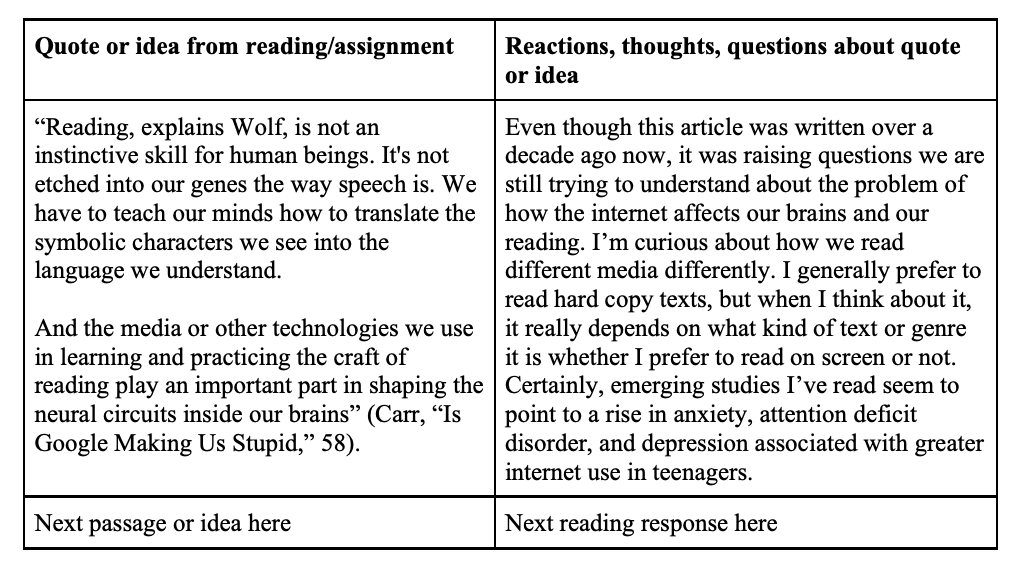20 Active Reading to Understand a Problem
Christian J. Pulver
“If you don’t have time to read, you don’t have the time (or the tools) to write. Simple as that.” -Stephen King
Understanding all the sides that make up a problem you are exploring depends on your ability to read actively. As we’ll cover in this chapter, reading actively entails many things, but here’s a good starting definition: Active reading is the practice and skill of making meaning through deep engagement with a text or other composition, using the basic techniques of re-reading, annotating, responding, and sharing. Though we may think of reading as a separate activity from writing, active reading emphasizes how the two work together to create deeper learning experiences. As world-renowned writer Stephen King suggests in the epigraph at the beginning of this chapter, writing well depends on taking the time to read.
Before turning to the basic strategies for active reading, let’s consider the role that discourse plays in understanding a problem we are trying to address. When starting to make sense of a problem, we first must make sense of the discourse that surrounds it. How are others writing and talking about the problem? What terms and concepts are common and shared in this discourse? What kinds of assumptions and beliefs are part of this discourse, and how do they frame the problem you are looking at? What arguments are made and what kinds of evidence are used? The purpose behind understanding the discursive and textual context of a problem is two-fold: first, it will help you understand the nature and nuances of the problem; and second, it will help you understand how to enter the conversation and contribute to its solution. In this way, active reading is not simply reading for information—it’s reading to learn how to think in a particular discourse about a particular problem.

From a cognitive and neurological perspective, reading actively is like lifting weights for the brain. Active reading creates neuronal pathways in our brains necessary for thinking and writing in that discourse. We often call this process “learning,” but, more specifically, when we read actively we are building a storehouse of concepts, ideas, words, logic, and meaning that we’ll need to know if we hope to understand a problem we are researching. In enriching our capacity to understand what we read, we are likewise developing immensely useful and transferable skills that we can apply when learning other discourses and solving other problems in different contexts.
Four Stages of Active Reading
In active reading, reading is more of a staged process than a single event. This process entails re-reading and common note-taking strategies like annotating, underlining, defining terms, and responding to passages you find relevant to the problem you are studying. The four stages of active reading are as follows:
-
- Introductory reading
- Participatory reading
- Analytical reading
- Lateral reading
Introductory reading is the stage where we systematically skim a text to get an initial feel for it based on the genre, title, sections, images, headings, length, author, and publisher. If we’re reading a longer text, we would also look over the table of contents or scan the basic layout and links of a website. In introductory reading our goal is to familiarize ourselves with the reading task in front of us and start priming our minds to undertake a more in depth participatory and analytical reading of the text.
In the participatory stage of active reading, our first full time through, we want to make sense of what the writer and the text are trying to communicate to us. What are the basic ideas in the text? What stance has the writer taken? Is there a thesis or another explicit purpose in the text? In this second stage of reading, start to annotate and take notes. Underline interesting quotes or passages, note your questions and reactions in the margins, and circle or otherwise mark key words and concepts.
After a participatory reading, the next stage is re-reading. This time we read with a more analytical eye, asking questions about how the text is organized and arranged. What rhetorical appeals are in play? Who is the intended audience? Is the text making an argument? What outside sources does the text draw on? In the analytical stage of reading we are thinking more rhetorically about how effective a text is, about its purpose, audience, organization, and style. Annotating, underlining, and responding should all be used in this stage as we re-read and deepen our understanding of both the meaning of the text and the discourse it is a part of.
Another important note-taking strategy for active reading that should be used in both participatory and analytical stages is double-entry notes (Image 2). In double-entry notes, the reader pulls out quotes or ideas they find interesting in a text and places them in the left column of a table. Then, in the right column, the reader explores their response by writing about their understanding/reaction to the quote/idea and why it’s significant. These responses might be personal reflections or questions, or they might help to work out the meaning of the passage by putting it in the words of the reader. Whatever the response, double-entry notes are a simple and effective way to deepen your engagement with a text, explore your thinking about it (metacognition), and develop a deeper understanding of the problem you are trying to address.

Lateral reading is the fourth phase of reading, where we start to place the texts we’ve read within a group of other circulating texts and compositions that are considering similar questions or problems. In this stage, readers are trying to understand the larger context the text is a part of and how it is in conversation with a network of other texts and media.
As you work through the four stages of active reading, you are developing the interpretive structures in your brain, allowing you to write more fluently about the problem you are exploring and, thus, to enter the conversation more effectively in the process.
Reading and Annotating on the Screen
You will develop your own process for reading actively, but here are some guidelines to get you thinking about your own reading practices and how to use writing as a way to read more actively on a screen.
- Try out a variety of tools and media when reading to see what works best for you. For example, many people reading on the screen take notes with pen and paper on their reading. Old technology like pen and paper continue to be useful tools for learning. Familiarize yourself with the various outlining and annotating tools now common in all word processing applications and learn about popular online writing and note-taking tools like Google Docs, Evernote, OneNote, or online research tools like Diigo and RefWorks. The choices are many, so find the tools that work best for your learning.
- The bigger the screen the better. Though many of us may not have access to a large computer screen, opening up a reading in a two-page spread and enlarging the text can create a much more comfortable and open reading experience than reading on a phone or tablet. Being able to see two pages will help you develop a more coherent sense of a text and how it’s organized.
- Change the background to black and the text to white. This is an easy technique to minimize eye strain if you are reading on the screen for long periods of time. All e-readers have this capability, as does Microsoft Word.

Summary of Active Reading Strategies
- Find a space where you can focus and minimize distraction. Consider silencing your phone and putting it away (in a bag or drawer) for a set amount of time while you are actively reading. Start with 15-minute sessions and add 15 minutes every few reading sessions until you can read uninterrupted for 60 minutes. This kind of incremental process will help you grow as a reader and greatly improve your concentration and focus.
- If the reading is confusing or feels dense, physically slow your eyes down and take the words in smaller, slower chunks until they make sense to you. Again, this is part of the intellectual training involved in active reading. As you slow down to read, you are training your brain to read more carefully and comprehend more quickly. Over time, your reading and comprehension speed will increase. While there is a time and a place for “speed-reading,” active reading, as we’ve defined it here, is slower and more intentional.
- Read in stages and re-read. As we’ve traced in this chapter, moving from introductory to participatory, analytical, and lateral readings will help you engage, understand, and remember what you read.
- Annotate and trace your thinking. Marking up the text, underlining key passages and concepts, noting your reactions, confusion, surprise—all of these kinds of annotations are central to reading actively and reading well. Such annotations will help you remember what you read, what was interesting to you, and give you ideas to draw on as you work through the problem you are researching.
- Read out loud and talk about your reading with others. Reading out loud may feel funny at first, but it’s a simple way to increase your comprehension by taking advantage of your ability to hear as well as see. Sharing what you’re reading with others and talking to them about it, or dialoguing about a question you have, is another easy way to deepen your understanding of text and your ability to “talk” the discourse it is a part of.
Media Attributions
- LiftingWeights © Christian Pulver adapted by Christian Pulver is licensed under a CC BY-NC-SA (Attribution NonCommercial ShareAlike) license
- DoubleEntryNotes © Christian Pulver
- WomanatComputer © fizkes/Shutterstock.com

